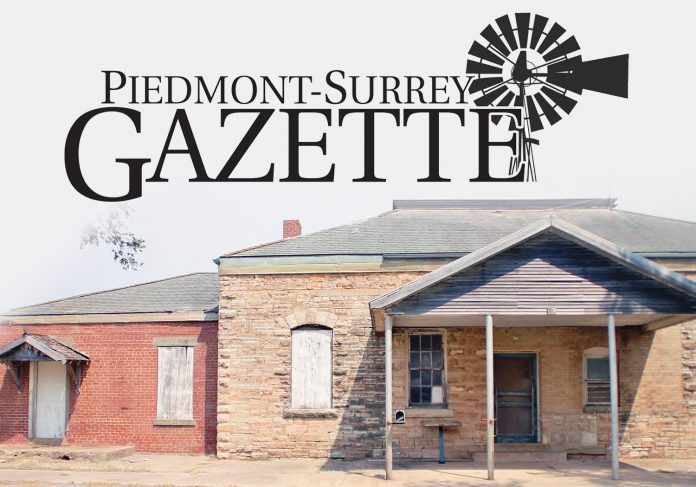
By Carol Mowdy Bond
Contributing Writer
EL RENO – The U.S. Department of Agriculture bulldozed eight or nine structures at historic Fort Reno this year. This demolition took place at some point since March. There are conflicting reports about whether or not the demolition has temporarily ceased.
Sitting on historic Route 66, just a few miles northwest of today’s El Reno in Canadian County, Fort Reno is listed on the National Register of Historic Places which is part of the U.S. National Park Service. The fort is a federal installation and belongs to the USDA. The USDA is accountable to Congress. In August, members of the Historic Fort Reno Board Inc. or HFRBI began sounding alarms about demolition of buildings at the fort without their knowledge. In March, the USDA closed the fort due to the pandemic. The fort grounds are now open, and visitors are roaming the grounds without staff present during certain hours and days. However, the four buildings, normally open to the public, remain closed by the USDA. And USDA staffers are still working from home.
The Agricultural Research Service is the principal in-house research agency for the USDA. And the Grazingland’s Research Lab at Fort Reno is at least one of the major players in the demolition discussion, with Dr. Patrick Starks as the interim director. When contacted by phone about the demolition, Starks said, “The work had to be done. We finally got the money. It had to be done. There was nothing nefarious about it.”
At least one USDA document states that the following have already or will be bulldozed: Machine Shop; Hay Barn; Coal House B19; Coal House B20; Coal House B5; Coal House B16; Coal House B9; and Garage by Bakery.
On September 22, Jan R. Suszkiw, public affairs specialist and acting chief of the media relations branch in the USDA’s office of communication, which is part of the USDA’s Agricultural Research Service in Maryland said, “For safety purposes, the USDA is currently demolishing 14 buildings that are located on the ARS El Reno property. Eight of the 14 buildings are considered historical and fall under the guidelines of the 1992 State Historic Preservation Office Programmatic Agreement. In 2017, USDA conducted a survey of El Reno facilities and the 14 buildings scheduled for demolition were found to be unsafe, uninhabitable and unable to be preserved. The report was presented to the Oklahoma SHPO, Oklahoma Archeological Survey, The Advisory Council on Historic Preservation, and the Historic Fort Reno Board of Directors, who supported demolishing the buildings for safety of the community; thereby, maintaining a safe environment and public access to the historic El Reno site. Permits were obtained and a memorandum of agreement that was signed in February 2020 between USDA and The Oklahoma SHPO to proceed with the demolition.”
Recently, information has been obtained regarding plans for historic buildings being demolished at Fort Reno, a number of the buildings that have already been razed.
The USDA plans to bulldoze more of the fort’s buildings.
The National Historic Preservation Act celebrated its 50th birthday in 2016. The basic premise is to set guidelines/protocol/steps to be taken, for any federal agency with a project that impacts a historic structure or site. When these situations occur, the federal agency with a planned project must meet standards. The act created the Advisory Council on Historic Preservation, somewhat of an independent oversight agency, which makes the federal agency subject to what is called the Section 106 review process. This process includes determining if the work will have an adverse impact on the historic site, and if so, alternatives need to be considered. The National Historic Preservation Act’s web site tab for the Section 106 process states: “This process is an important tool for citizens to lend their voice in protecting and maintaining historic properties in their communities.”
According to one source, the federal agency, in this case the USDA, that has a project impacting a historic site, in this case Fort Reno, must contact every entity related to or with any interest in the site. This may be a variety of entities including nonprofits, Native American tribes, municipalities, historical groups that have an interest, and other. But the guidelines require more than just sending an email. The USDA had the responsibility of contacting all the entities, and also making sure the entities actually received the contact, and also giving the entities opportunity to be at the table as part of the discussion if they so desired.
The USDA documents state that the USDA contacted the Cheyenne & Arapaho Tribes. This contact was made by email. But the USDA document states the tribe did not respond. And on the memorandum of agreement that has been unearthed at this point, the tribe has no signatory. According to a source, it was up to the USDA to follow up and make sure the tribe received the information and then brought the tribe to the table if desired.
The Historic Fort Reno Board Inc. LLC group has a constant presence at the fort. They oversee, plan, maintain, and carry out all kinds of things involving the visitor’s center and museum functions, tourists on the grounds, tours, events on the grounds, grant monies, fundraisers, and more. They even make sure the temperature is always correct in the museum so artifacts are correctly preserved. The fort museum curator serves on the board. Yet this group is not mentioned in any documents found to date, and the group claims in late summer they learned of the eight bulldozed buildings when they found the buildings were just flat gone. Not there anymore.
Whether or not the USDA contacted the City of El Reno has not been established. The city is not listed in the documents found to date.
The ACHP source claims that any entity that should have been contacted, but was not contacted, has the legal right to sue the USDA.
Another conundrum in this situation is the state level agencies connected to the National Historic Preservation Act. The act requires each state shoulder a lot of weight in these situations, and as a result, Oklahoma has a State Historic Preservation Office with people who are attached to our state historical society. The State Historic Preservation Office deputy officer had to sign off on the bulldozing done by the USDA at Fort Reno. Amazingly, the deputy officer said all relevant documents are public domain, but the ones I asked for could only be accessed through her, and she was unwilling to discuss one particular document or to even discuss this matter at all, and she is referring all questions to the USDA. But the USDA thus far gives conflicting information, or doesn’t respond at all.
A federal preservation officer, and a list of people who reside in other states who have various official titles, who signed the documents for the Fort Reno demolition projects. The USDA informed all of them of the bulldozing to be done at Fort Reno and made sure they all signed the memorandum of agreement, and that they were all at the table.

One memorandum has signatures dated as recently as February of this year. So, since the process, leading to the bulldozing, began possibly as early as 2016 or maybe even before that, there’s been plenty of time to contact everyone, including “citizens,” and follow the protocol outlined in the federal preservation act and the Section 106 process.
Another issue is an elusive December 2017 document that cannot be accessed.
The Agricultural Research Service (ARS) is the principal in-house research agency for the USDA. And the ARS Grazingland’s Research Lab at Fort Reno is at least one of the major players in this equation.
U.S. Sen. James Inhofe has commented on the issues.
“Over the past few weeks, I’ve heard from members of the Fort Reno community who are concerned about the demolition of buildings at historic Fort Reno. I understand their frustration. It appears that the USDA and the State Office of Historical Preservation have not done a good job of commincating the process, timing and action being taken. Some of the buildings are in exreme disrepair at Fort Reno but that doesnt excuse poor communication with community stakeholders.”
Of note in the memorandum is that starting at the time of the memorandum’s execution, the agency has 18 months to carry out the project, or they basically have to start over again.
The USDA is accountable to the U.S. Congress. And so far, the agency doesn’t appear to be acting in a transparent manner with Oklahoma’s congressional delegation.
Has bulldozing temporarily ceased at Fort Reno? There are several answers to that question.
The USDA appears to have acted in a similar manner with at least one other historic fort. Fort Keogh is near Miles City, Montana. Well, the fort was there, until it wasn’t anymore.
The fort has origins and history that are eerily similar to that of Fort Reno. And there’s a USDA ARS lab there: a 55,000 acre livestock and range research center. Back when the weathered and neglected historic structures still existed. Ten of the fort’s buildings were destroyed by fires over the years.





